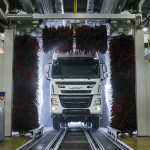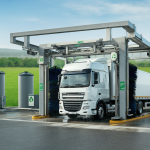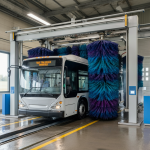For fleet managers and bus operators, keeping your vehicles clean is more than just about looks. Regular bus washing ensures the longevity of your fleet, reducing corrosion, maintaining paint quality, and keeping your brand image professional. But choosing the right automatic brush bus wash equipment isn’t always straightforward. With so many options available, it’s crucial to understand your fleet’s unique needs and weigh the features, costs, and long-term benefits of each system.
This guide will help you assess your requirements and choose the best solution for your transportation business.
Why Regular Washing Matters for Your Fleet
Unclean buses aren’t just an eyesore; dirt and grime can significantly damage paint and cause corrosion over time. John Smith, Fleet Maintenance Manager at ABC Transportation, emphasizes, “Regular washing not only keeps your fleet looking professional but also protects the paint and extends the life of your buses.”
For transportation companies, clean vehicles aren’t just about aesthetics. They reflect your company’s commitment to quality and professionalism. Besides, vehicles covered in dirt or debris can carry pollutants, sometimes even violating environmental regulations.
Types of Automatic Bus Wash Systems
Brush vs. Touchless Systems
When exploring bus wash systems, the first question is whether you need a brush-based system or a touchless system. Here’s a quick breakdown of each:
Brush Systems (including Gantry Brush Wash systems)
- How it works: Brushes physically scrub the surface of the bus, ensuring a deep clean.
- Advantages: Highly efficient, quicker cleaning cycles, and ideal for removing stubborn dirt and grime.
- Best suited for: Buses with durable exterior finishes.
Specific models, such as the 3D Profiling Gantry Brush Wash Equipment, take cleaning precision to the next level by adjusting to the contours of the bus for a consistent clean.
Touchless Wash Systems
- How it works: Uses high-pressure water jets and detergent, with no physical contact.
- Advantages: Reduces the risk of scratches and is better suited for custom-painted or delicate exteriors.
- Limitations: May not remove heavy grime as effectively as brush systems.
Each system has its place, but most fleet managers opt for automatic brush wash systems due to their combination of efficiency and thorough cleaning capabilities.
Key Features to Consider
Once you’ve decided on the type of system, it’s time to evaluate specific features that will impact your operations.
1. Size & Dimensions
The wash equipment should accommodate the dimensions of your largest vehicles. Consider the height, width, and length to ensure compatibility.
2. Throughput & Efficiency
How many buses do you need to clean daily? Systems with higher throughput can handle multiple vehicles in succession, saving time and labor.
3. Water Usage
Look for systems that offer water-recycling capabilities. Efficient water management not only lowers operational costs but is also better for the environment.
4. Brush Material
The type of brush material can affect both cleaning performance and long-term durability:
- Foam brushes: Gentle on paint while providing a thorough clean.
- Bristle brushes: More robust but may cause wear on sensitive surfaces over time.
5. 3D Profiling Technology
Innovative features, such as 3D Profiling Gantry Brush Wash Equipment, ensure the brushes conform to every contour of the vehicle, providing consistent cleaning performance no matter the shape.
6. Customizable Detergent Options
Look for systems that allow you to adjust detergent strength to suit various cleaning conditions, such as harsh weather residue or mud buildup.
Evaluating Your Needs
Selecting the right system begins with understanding your company’s specific requirements.
- Fleet Size: Larger fleets often require high-throughput systems with faster cleaning cycles.
- Space Constraints: Do you have room for a full gantry system, or would a smaller drive-through option fit better in your facility?
- Budget: While upfront costs are important, consider long-term savings in labor, water, and chemical costs.
Installation and Maintenance: What to Expect
Installing an automatic bus wash system is a significant investment, so it’s important to understand the process. Here’s what you can expect:
- Installation Timeline: Most installations can take a few weeks, depending on the complexity of the system and your facility’s setup.
- Employee Training: Staff should be trained to operate the system efficiently and perform routine maintenance tasks.
- Regular Maintenance: Schedule routine inspections and servicing to prolong the life of your equipment. Preventative maintenance is critical for avoiding costly downtime.
Additionally, partner with a vendor that offers strong after-sales support, ensuring you always have help when needed.
ROI and Long-Term Cost Savings
While the initial cost of a bus wash system may seem high, the long-term savings often justify the expense. Consider these factors when calculating ROI:
- Reduced Labor Costs: Automated systems dramatically reduce the need for manual cleaning.
- Lower Maintenance Costs: Regular washes prevent long-term damage to your fleet’s exterior, lowering repair costs.
- Water Savings: Efficient systems with water-recycling capabilities reduce water waste and costs.
Ultimately, investing in quality equipment ensures significant savings over the lifetime of the system while keeping your fleet in top condition.
Success Stories from Other Operators
Here are a few real-life examples of fleet operators who have seen the benefits of automatic brush wash systems:
- Urban Transit Co. in California reduced washing times by 35% using a Gantry Brush Wash system, streamlining operations for their 150-bus fleet.
- EcoBus Travel upgraded to a 3D profiling wash system and cut water usage by 40%, saving over $15,000 annually.
These case studies demonstrate how modern systems improve efficiency and cost-effectiveness.
Making the Right Choice for Your Business
When it comes to selecting the right automatic brush bus wash equipment, there’s no one-size-fits-all solution. By considering your fleet size, space, and key features like throughput and water usage, you can invest in a system that aligns with your operational goals.
Taking that first step can seem daunting, but making the right choice today will lead to years of smoother operations and cost savings. If you’re ready to elevate your fleet maintenance, consider exploring industry-leading options like the 3D Profiling Gantry Brush Wash Equipment.
Make the smart choice to keep your fleet clean, professional, and running for years to come.




